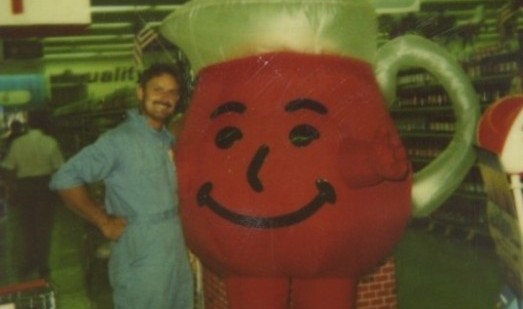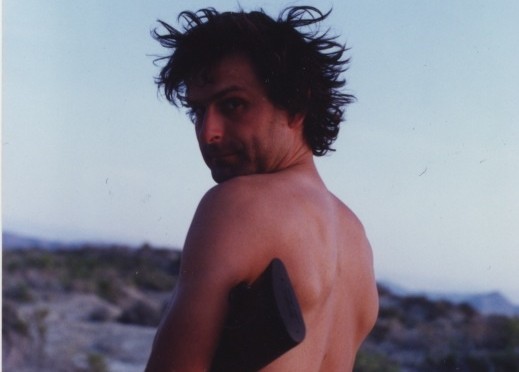The Lost Hour Challenge / An Interview with John Law
Fri 28 Nov 2014“Law is an urban adventurer of the highest order — a radical-experience organizer and a thought-revolutionary-in-the-
night. He and his more shadowy Cacophony co-conspirators are the closest thing you’ll ever meet to Tyler Durden, and they most likely served as the character’s inspiration.”
AND along with the wonderful The Influencers Festival (taking place in Barcelona this weekend), teamed up with one of our subculture heroes John Law, the internationally renowned icon of underground culture, co-founder of the San Francisco Cacophony Society, Burning Man and Billboard Liberation Front. To set a provocation to a new generation of creative troublemakers, The Lost Hour Challenge.
John Law was among the founders of The Cacophony Society in 1986. Emerging from the ashes of the mysterious and legendary Suicide Club, the Cacophony Society was an informal, unclassifiable group of anonymous people who spent their time exploring the boundaries of conformist society, and occasionally crashing them. They sought imagination, adventure and mutual trust beyond the pale of those provided by mainstream society; that involved playful ways of disrupting propaganda, mocking respected symbols (like in their infamous Santarchy, an invasion of rebellious Santas), exploring forbidden urban spaces (from sewers to bridges), rebuilding freedom through mayhem, confusion, dangerous operations and sometimes outright madness. Mostly harmless, often illegal, always fun.
The Challenge is part of AND’s autumn online programme The Lost Hour, marking the occasion when once a year clocks across the world are brought back one hour. Using this as inspiration to ask artists and audiences – if you could get away with it, what would you do with the hour that gets lost?
John kicked off the challenge with this short 30 second video and we caught up with him this week to talk more about it.
Tell us more about The Lost Hour Challenge and why you were interested in getting involved with Abandon Normal Devices and The Influencers.
The idea of The Lost Hour Challenge came from AND. I love it. It encourages participants to think carefully about what kind of space they might be in during an hour that doesn’t exist – this type of freedom opens many portals in the mind allowing one to re-imagine the environment.
My contribution was to add the goal of actively choosing a physical (or mental or emotional) space that the respondent believes is overlooked by most or all people even though they might pass by that space every day.
This exercise works ones brain out much like physical exercise increases your muscle strength. You begin to SEE what’s really all around you and how things might look from these unknown and ignored spaces.
In The Lost Hour Challenge we see you scaling a bridge in San Francisco (a feat which we think looks pretty dangerous and takes a lot of both skill and balls!). Why did you do it?
Well, I just happened to be there on the bridge recently, more by luck than design. Most people think that bridges are merely roads that one drives on. As you can see, nothing could be farther from the truth regarding these structures. They are obviously giant jungle gyms, unintentional play structures allowing the adult child an opportunity to scramble all about them like a chimp or perhaps a big kid on a sugar rush.
Although a major suspension bridge is perhaps an extreme example of this “synesthesia of place” you can see the utility of so many physical environments that most people pass unknowingly, as places to explore, to play in. You only need to know how to look. And almost anyone can learn.
 Have you any advice for new adventurers out there?
Have you any advice for new adventurers out there?
Adventure is everywhere if you have time and disposable income. If not, it isn’t called “adventure” even though survival could certainly be characterized as adventure. Adventures are not always fun.
Climbing bridges is much safer than walking down the street in many places. The problem with walking down streets is that other people can get at you. And other people are, by far the most dangerous thing that we encounter on a daily basis. Other people in cars, other people walking, other people drunk, other people who are mad at someone else, not necessarily you – but you will do!
So for me, I feel MUCH safer when in a “negative” space. These are places that we all can access – it just requires looking. When I walk with my young son, we look down into every grate and up into every tree, hillside or building.
General advice: Don’t hurt me. Don’t hurt yourself. Don’t hurt the general public. Don’t get caught! Have fun!
You’re often referenced as an inspiration for the cult Fight Club character Tyler Durden, how do you feel about that?
Rule #1 of Fight Club is YOU DO NOT TALK ABOUT FIGHT CLUB!
Rule #2 of Fight Club is YOU DO NOT TALK ABOUT FIGHT CLUB!
Kidding! Chuck Palahniuk was a member of Portland Cacophony. I was at the premier Portland Cacophony event along with other San Francisco Cacophony members but I don’t remember him.
The event was an Atomic Cafe and it took place in a colossal abandoned Greyhound Bus repair building. I believe that Palahniuk had worked there (he was a diesel engine mechanic before he became successful at writing) years before.
Then I met him on the Portland SantaCon in 1996. I tell that story elsewhere. He had just published Fight Club (small hardback edition) and was an unknown first-time published novelist. He seemed quite excited to be published. He gave me a copy of the new book.
I then promptly forgot about the encounter until a couple of years later when they started making the movie of the book. Summer Burks called me and asked if I knew about “the Cacophony movie with Brad Pitt” I said no, and it took a while for me to realize that the story was from the intense Santa-Chuck in Portland who gave me the book a couple of years before.
I immediately dug the book out of a pile on my shelf and read it for the first time. I thought it was a great work – the closest thing the the American Generation X,Y and Z’s had to an On the Road by Kerouac. Another guy with a hard to spell last name!
 The Cacophony Society inspired a new generation of troublemakers (such as the Yes Men, Improv Everywhere and Survival Research Laboratories) and sprouted offshoots in the form of the Billboard Liberation Front and Santarchy/SantaCon. But it still remains relatively unknown. Why do you think this is and do you or the any of the Cacophony Society even care?
The Cacophony Society inspired a new generation of troublemakers (such as the Yes Men, Improv Everywhere and Survival Research Laboratories) and sprouted offshoots in the form of the Billboard Liberation Front and Santarchy/SantaCon. But it still remains relatively unknown. Why do you think this is and do you or the any of the Cacophony Society even care?
We were not in it for the money, power, sex (well OK, SOME of us were in it for the sex) or attention. It was our lives. And no one of us owned it. The philosophy was already there from the earlier Suicide Club, we were living it at night while holding down our day jobs and normal fronts.
Survival Research Laboratories (SRL) was an independent organization that evolved concurrent with the Suicide Club. Over the years, we worked together, cross bred members and became fast friends and co-conspirators, but SRL was and is an independent, singular group.
The Billboard Liberation Front grew out of Suicide Club and paralleled the Cacophony Society (same people, different names). Santachy was a direct outgrowth of Cacophony but YesMen are their own thing. I don’t know if they were originally inspired by Cacophony or not, but we came to know them.
I recall corresponding with Igor Vamos when he was doing the Barbie Liberation Organization in the early 90’s. He also shared a dorm room with Suicide Clubber Ben Friedman and (later) Cacophonist (co-founded Brooklyn Cacophony) and Burning Man gate manager William Abernathy.
The Cacophony Society could be described as an underground viral group, with off shoots in cities all cross the US. How did this way of working and underground communication come about?
Cacophony, Burning Man and Santarchy grew and blossomed concurrent with the rise of the internet and advent of social media. San Francisco Cacophony was right in the heart of the internet revolution, Silicon Valley.
There was a lot of cross over. I could name many that were in Cacophony and/or The Suicide Club or SRL that were integral in the new world of internet connectivity. This was a happy circumstance, and like so many things in life, unplanned and serendipitous.
SantaCon became a “meme” and blasted off for good or bad all over the world.Burning Man became the vacation of choice for the nascent millionaires (and billionaires) of the Valley. This, of course, changed everything about it, bleaching much of the original “anarchist” spirit out of the event.
This original Cacophony spirit lives on in Burning Man, not in the bloated hierarchy that owns the festival and directs the brand, but in participants who “find out what they ARE SUPPOSED TO DO at the festival and then do something else.”
Recent Journals
- A Gig at Sunrise: Reflecting on W Brzask at Ephemera Festival
- Announcing our THREE FIELDS artists
- New Rhythms
- Introducing Commons // Keiken and Jazmin Morris
- Introducing our Creative Associates programme
- Reflections on the Associate Board Member Programme
- The Future of Arts Governance
- Rendering our virtual, net and digital discourses
- Announcing a new partnership between AND and the School of Digital Arts
Other Journals
-
2025
-
2024
-
2023
-
2022
-
2021
-
2020
-
2019
-
2018
-
2017
-
2016
-
2015
-
2014
-
2013
-
2012
-
2011



